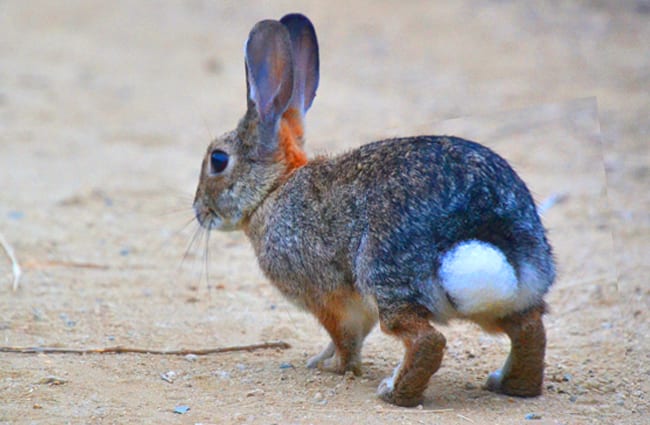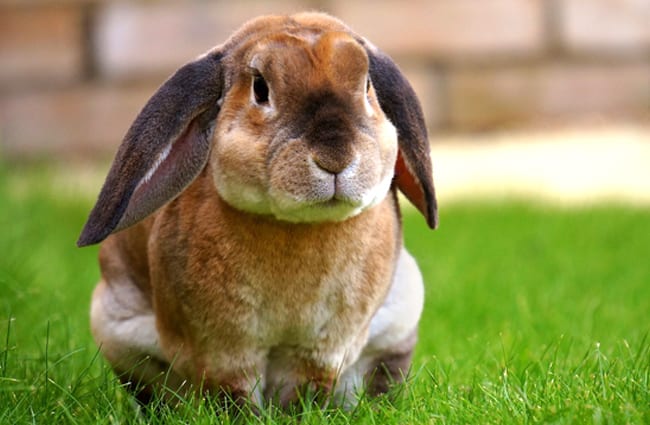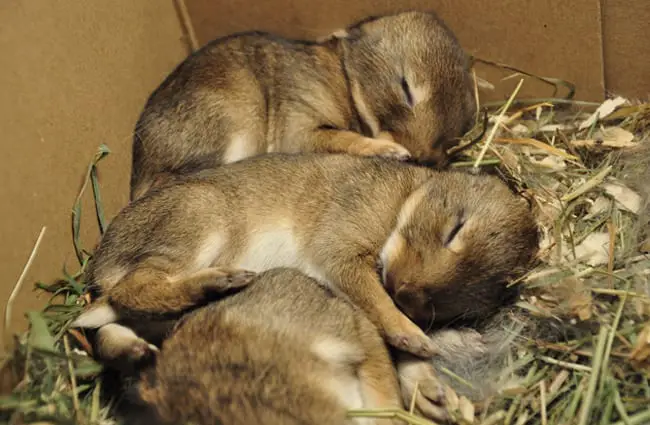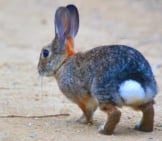The Rabbit is any number of mammals in the Leporidae family. Rabbits, also known as “bunnies,” are closely related to hares and pikas. Researchers recognize 17 different species of these animals, and 8 different taxonomic genuses. Read on to learn about the Rabbit.
Description of the Rabbit
Most people recognize a Rabbit when they see one. It usually has a rather stout body, a rounded back, long ears, and a short tail. It also has strong hind legs and long rear feet.
Though domestic variations come in many different colors, wild individuals usually have tan or brown fur. This coloration keeps predators from easily spotting them, as opposed to the bright white, dark black, or spotted fur of some domestic breeds.
Interesting Facts About the Rabbit
Each species is different from the next, but they all have unique traits and adaptations to help them survive. Learn what makes these little mammals so interesting below.
- Long Legs – Though they have relatively short front legs, all Rabbits have long, strong rear legs. They use these legs, which are quite muscular, to run and jump at impressive speeds. When they run, they only place their toes on the ground rather than their entire foot.
- The Better to See You With – These creatures have large eyes placed quite high on their heads. This allows them to see nearly everything around them. In fact, their only blind spot is a small area right at the end of their nose.
- The Better to Hear You With – Everyone knows about the Rabbit’s large ears. Those long ears help them hear predators from a distance to avoid becoming dinner! They also help the mammals cool off in hot weather.
Habitat of the Rabbit
Though many species live in meadows, grasslands, woodlands, mountainous areas, and similar habitats, these mammals also occupy more specialized ecosystems. Some species prefer living in one type of habitat, like wetlands, marshes, estuaries, and even volcanic areas. Some also occupy more urban areas like farms, parks, gardens, and suburbs.
Distribution of the Rabbit
These mammals live across a variety of regions worldwide. They naturally occur in Eurasia, Africa, and North, Central, and South America. Humans have also introduced various species to other regions of the world as invasive species.
Some species live across wide regions or entire countries. Other species occupy just a tiny area. Each species has its own unique range and distribution.
Diet of the Rabbit
Rabbits are herbivores, which means they feed on plants. Their diets primarily consist of grasses, weeds, leaves, flowering plants, and more. Some species feed only on certain plants while others eat just about anything that they can.
The problem is, plants are quite hard to digest fully. Because of this, these mammals frequently rechew their feces after it passes through their digestive systems the first time.
Rabbit vs. Hare
At first glance, hares just look like Rabbits, with extra-long legs and ears. Outside of their appearance, these creatures differ in several different ways.
Save for a few species, the Rabbit is mostly social. It spends its time living in small groups, often in burrows underground. The hare usually lives alone, and stays above the ground. In their burrows, Rabbits also give birth to helpless babies and care for them for several weeks. On the other hand, hares give birth to fully formed and mobile young that require less care.
Rabbit and Human Interaction
Humans have utilized these mammals as a food source for thousands of years. We also used their fur to produce various clothing items, blankets, and other items. Farmers also consider these creatures as pests, because they eat or damage crops.
Human impact on the populations of different species varies. Some have strong populations, while others are in decline.
Domestication
Humans began domesticating these mammals in the times of Ancient Rome. Originally, we domesticated them as a source of food and fur. However, beginning in the 19th century, humans bred bunnies for their disposition as pets.
Nowadays, people keep many breeds for their meat or fur, but they also keep them frequently as pets. People have produced over 300 different Rabbit breeds throughout the years.
Does the Rabbit Make a Good Pet
Domestic varieties do make good pets. Even breeds originating from meat or fur production make good pets. Breeders have selected the friendliest and most social individuals for hundreds and thousands of years to produce the pets you own today. However, you should always do your research before purchasing a new pet.
Rabbit Care
Rabbits need to live in proper enclosures, have the correct diet, and plenty of socialization. Many owners keep their bunnies in cages, but let them roam throughout the day while they are home. You can usually litter box train them, so they will not mess outside of their cage.
It is incredibly important to give your bunny a variety of chewing opportunities, toys, and other stimulus. You should also provide a specially produced diet with balanced vitamins and minerals, as well as fresh vegetables to browse on.
Behavior of the Rabbit
Most wild individuals are nocturnal, or active at night. Some are also crepuscular, or active early in the morning and late in the afternoon. During the daytime, they sleep in burrows or tunnels underground.
Though they usually live in small groups, cottontail bunnies are often solitary. However, even solitary species congregate around prolific food sources. Groups live in burrows and defend their territories, and thus their food sources, from other groups.
Reproduction of the Rabbit
Females begin breeding when they are between the ages of three and eight months old. Their gestation period lasts about a month. Most litters contain between five and eight young, known as “kits.” The kits are helpless at birth but develop quickly. Females can breed several times in a single year.
Beliefs, Superstitions, and Phobias About the Rabbit
Because we have historically hunted Rabbits for thousands of years, these creatures are quite present in cultural and historical depictions. You can find them in artwork, folklore, and literature. Cultures from Aztec mythology to Chinese, Japanese, and Korean traditions all feature these creatures.
In cultural depictions, bunnies hold many different symbolisms, from fertility to innocence, youth, cowardice, peace, and more.















![Red Angus Closeup of a beautiful Red Angus cowPhoto by: U.S. Department of Agriculture [pubic domain]https://creativecommons.org/licenses/by/2.0/](https://animals.net/wp-content/uploads/2020/03/Red-Angus-4-238x178.jpg)












![Red Angus Closeup of a beautiful Red Angus cowPhoto by: U.S. Department of Agriculture [pubic domain]https://creativecommons.org/licenses/by/2.0/](https://animals.net/wp-content/uploads/2020/03/Red-Angus-4-100x75.jpg)

